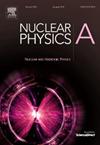以矢量耦合常数gρ = 为值的NJL模型中e+e− → π+π−和τ− → π−π0ντ过程的描述
IF 1.7
4区 物理与天体物理
Q2 PHYSICS, NUCLEAR
引用次数: 0
摘要
用向量耦合常数gρ=6,证明了e+e−→π+π−和τ−→π−π0ντ过程可以用统一的方法描述,与实验结果吻合较好。在这种情况下,除了夸克环外,还需要考虑1/Nc中下一阶对应的介子环。当描述γ(W)→ρ跃迁时,以及最终态中介子的相互作用时,必须考虑到这些环。本文章由计算机程序翻译,如有差异,请以英文原文为准。
Description of the processes e+e− → π+π− and τ− → π−π0ντ in the NJL model with value of the vector coupling constant gρ = 6
It is shown that the processes and can be described in a unified approach in satisfactory agreement with experiment using the vector coupling constant . In this case, in addition to quark loops, it is also necessary to take into account meson loops corresponding to the next order in . These loops must be taken into account when describing the transition, as well as in interaction of mesons in the final state.
求助全文
通过发布文献求助,成功后即可免费获取论文全文。
去求助
来源期刊

Nuclear Physics A
物理-物理:核物理
CiteScore
3.60
自引率
7.10%
发文量
113
审稿时长
61 days
期刊介绍:
Nuclear Physics A focuses on the domain of nuclear and hadronic physics and includes the following subsections: Nuclear Structure and Dynamics; Intermediate and High Energy Heavy Ion Physics; Hadronic Physics; Electromagnetic and Weak Interactions; Nuclear Astrophysics. The emphasis is on original research papers. A number of carefully selected and reviewed conference proceedings are published as an integral part of the journal.
 求助内容:
求助内容: 应助结果提醒方式:
应助结果提醒方式:


